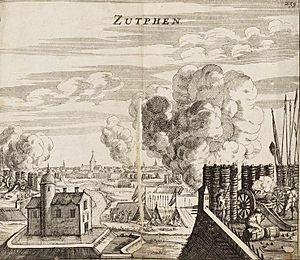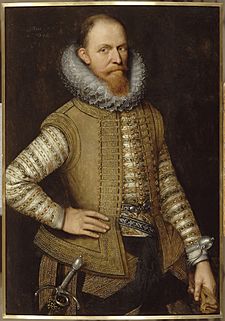Siege of Zutphen (1591) facts for kids
Quick facts for kids Siege of Zutphen (1591) |
|||||||
|---|---|---|---|---|---|---|---|
| Part of the Eighty Years' War & the Anglo–Spanish War | |||||||
 The Capture of Zutphen in 1591 - print by Jan Janssonius |
|||||||
|
|||||||
| Belligerents | |||||||
| Commanders and leaders | |||||||
| Strength | |||||||
| 9000 soldiers 1,600 cavalry |
1,000 (Spanish and Walloons) | ||||||
| Casualties and losses | |||||||
| Light | Most captured | ||||||
The Siege of Zutphen was a short battle that lasted eleven days. It took place in 1591 during the Eighty Years' War and the Anglo–Spanish War. Dutch and English troops, led by Maurice of Nassau, surrounded the city of Zutphen. They used a clever trick to start the siege. After just eleven days, the Spanish soldiers defending the city gave up.
What Happened Before the Siege?
Zutphen was an important trading city located on the east bank of the IJssel River. In 1572, the Dutch people began fighting for freedom from Spain's King Philip II of Spain. Zutphen was first captured by Dutch troops. However, the Spanish, led by Don Frederick, soon took it back. The people of Zutphen faced harsh consequences for surrendering earlier that year.
In 1586, English forces, led by the Earl of Leicester, captured an important fort outside Zutphen called a sconce. But soon after, an English soldier named Rowland York switched sides and gave the sconce to the Spanish. This left Zutphen completely under Spanish control. Another English commander, William Stanley, then gave the nearby town of Deventer to the Spanish as well.
By 1590, Maurice had successfully captured the city of Breda by hiding soldiers inside a boat filled with peat (a type of fuel). This victory gave him a strong base for future attacks. The Dutch army could now plan to attack in different directions. Maurice decided to head east towards Nijmegen along the IJssel River.
At the start of 1591, Maurice's main goal was to take Zutphen back. Using the rivers and canals nearby, he could move his troops and cannons quickly. This also stopped the Spanish from sending more soldiers to help the cities under attack. Zutphen was defended by about 1,000 Spanish and Walloon soldiers. An important sconce was also located on the west bank of the river.
The Siege Begins
Maurice's army was made up of 9,000 soldiers and 1,600 cavalry (soldiers on horseback). They marched to Zutphen with 100 ships. Their fast march, completed in just five days, allowed Maurice to get his cannons ready quickly. Moving cannons by ship was much easier than dragging them over muddy land.
To capture Zutphen, the sconce on the west bank of the river had to be taken first. This fort controlled the main bridge leading into the town. Once the sconce was captured, the main siege of Zutphen could begin. All the heavy cannons from the ships could then be brought ashore.
Maurice hoped to use another clever trick, similar to the one he used at Breda. Francis Vere, who was in charge of the English troops, wanted to clear the English name after the earlier betrayal. He asked to lead the attack. Maurice agreed and told Vere to take the sconce on the Veluwe (a region) across from Zutphen. He planned to send only about a dozen men, disguised as farmers, some even dressed as women. The hope was that the Spanish defenders would think they were refugees escaping the Dutch army and let them inside the fort. If the sconce was captured, Zutphen would have little chance of holding out.
Vere led the English troops to Doesburg and put the plan into action. The disguised soldiers ran towards the fort, pretending to be chased by a fake cavalry charge. The Spanish guards opened the gates and let the disguised soldiers in. The English even pretended to sell butter, cheese, and eggs to the guards. When the signal was given, the English quickly overpowered the guards. This allowed the Dutch cavalry to rush in, followed by the rest of the troops who had been hidden behind a large hill nearby. Soon, the combined Anglo-Dutch force defeated the Spanish soldiers. They then turned the sconce's cannons towards Zutphen itself.
After this successful trick, the bridge was secured. Count William Louis's Frisian companies also arrived, making Maurice's army even stronger. Maurice then began the main attack. Dutch gunners brought thirty cannons to three different spots. They started firing at the city. The Spanish soldiers defending Zutphen soon realized that fighting any longer was useless. They surrendered to the attacking forces.
{{gallery class="center" widths="300px" heights="250px" File:Het beleg van Zutphen (1591) door Prins Maurits - The siege of Zutphen in 1591 by Prince Maurice (Bartholomeus Willemsz. Dolendo).jpg|Siege of Zutphen in 1591 by Bartholomeus Dolendo - The English are attacking the sconce at top of picture File:The taking of Zutphen.jpg|The disguised English soldiers take the sconce, from a Victorian book }}
What Happened After the Siege?
The city of Zutphen, which had been difficult for the Dutch to capture, was now firmly in their hands. The Spanish had lost an important city. The terms of surrender were fair: the Spanish soldiers were allowed to leave. The citizens of Zutphen had three days to either leave the city or promise loyalty to the Dutch Republic. After placing a strong group of soldiers in Zutphen, Maurice marched north with his army. His cannons and supplies were sent down the IJssel River in boats. His next target was the city of Deventer.
Francis Vere was called 'the fox' because of his successful trick during the siege. He also had the body of Rowland York, the soldier who had switched sides, dug up and put on display as a reminder of his actions. Zutphen remained under Dutch control for the rest of the war.
See also
 In Spanish: Sitio de Zutphen (1591) para niños
In Spanish: Sitio de Zutphen (1591) para niños
- Battle of Zutphen
- List of stadtholders in the Low Countries
- List of governors of the Spanish Netherlands


